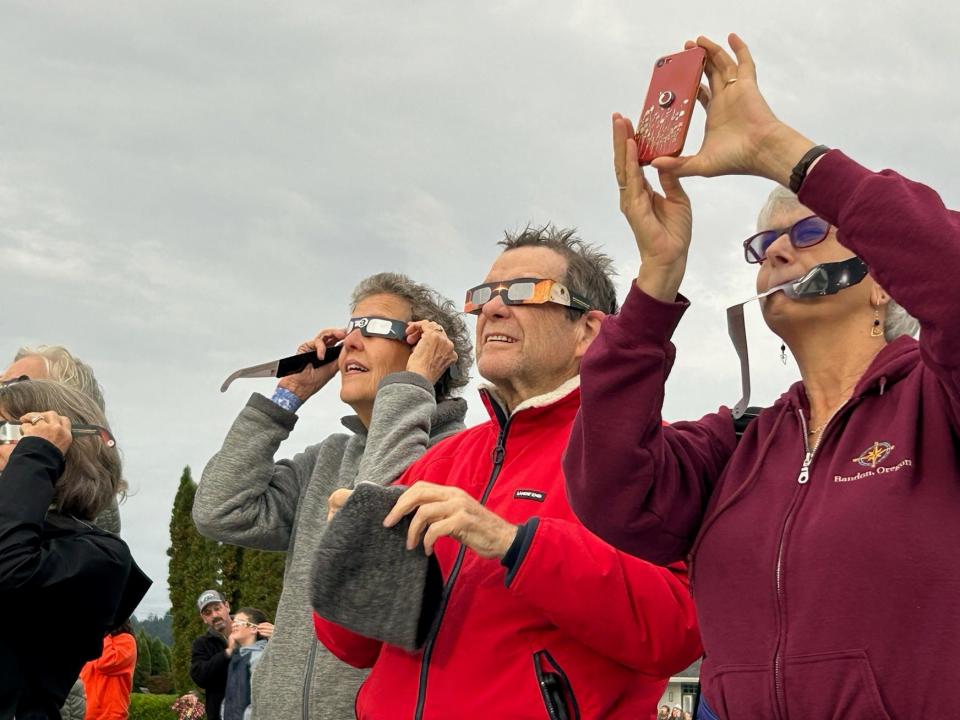Peak coverage in Oregon will range from 11:20 to 11:30 a.m. when the sun is pretty high, so we should be able to see the eclipse pretty much anywhere, weather permitted.
Among the places that should be popular viewing areas in and around Eugene are:
- Skinner’s Butte in Eugene.
-
Spencer Butte south of Eugene.
-
College Hill Reservoir on Lawrence Street between 24th and 25th avenues in Eugene.
“You don’t need to go on top of the mountains or anything, but maybe on top of a hill … anywhere that you’ve got a nice, open view of the southern sky,” said University of Oregon astronomy professor Scott Fisher.

Because Oregon is already so far from this eclipse’s path of totality, Fisher said there’s also no need drive any where for a better view. Across the entire state, the difference in percent coverage at peak is only about 5%.
“We’re sort of out on the fringe of the eclipse this time where we’re only getting this sort of 25% coverage,” he said.
When is the 2024 eclipse?
The entire partial eclipse from start to finish will be about three hours in Oregon. The moon will begin covering the sun at about 10:30 a.m. and move away at about 12:15 p.m.
Viewers in Eugene will see a peak of 24% coverage at 11:23 a.m. In Salem, the peak will be at 11:24 a.m. Across all of Oregon, the peak will range from around 11:20 to 11:30 a.m.
Weather permitting, the sun will be high in the sky at the time of the eclipse, however, cloud coverage could affect the viewing experience. According to the National Weather Service, both the Eugene and Salem areas are usually overcast 50% of the time in April and only clear about 10% of the time.
Watch NASA’s live coverage of the 2024 total solar eclipse
NASA will have live coverage of the eclipse from 10 a.m. to 1 p.m. as the eclipse travels through Mexico and across the United States.
Coverage will include live views across the path, expert commentary and live demonstrations
Don’t forget these solar eclipse viewing safety tips
-
Never look directly at the sun without proper eye protection, as it is harmful to your eyes at any time during a partial eclipse.
-
Regular sunglasses, no matter how dark tinted, are not safe for viewing.
-
Eclipse glasses are the best option. Be sure they are made by companies recommended by the American Astronomical Society and NASA certified. These glasses should have the International Organization for Standardization icon and must have the ISO reference number 12312-2.
-
Always inspect your eclipse glasses or handheld viewer before use. If torn, scratched or otherwise damaged, discard the device.
-
Without eclipse glasses, a simple and safe way to view the eclipse is to watch the sun’s image projected onto a piece of paper. Poke a small hole in an index card with a pencil point, face it toward the sun and hold a second card 3 or 4 feet behind it in its shadow. You will see a projected image of the sun on the second card.
-
Do not look at the sun through a camera lens, telescope, binoculars or any other optical device while wearing eclipse glasses or using a handheld solar viewer, as the concentrated solar rays will burn through the filter and cause serious eye injury. These require different types of solar filters that attach to the front of the device.
See also What time is the April 8 total solar eclipse in Oregon? Find out here with your ZIP code
This article originally appeared on Register-Guard: Best places to watch the eclipse from in and around Eugene
